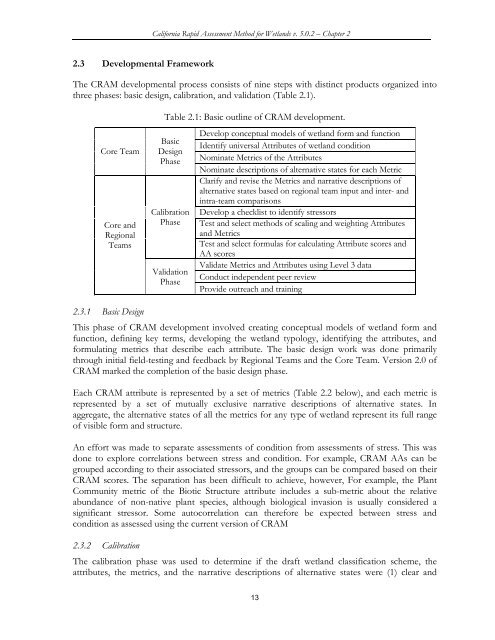(CRAM) For Wetlands User's Manual Version 5.0.2
(CRAM) For Wetlands User's Manual Version 5.0.2
(CRAM) For Wetlands User's Manual Version 5.0.2
You also want an ePaper? Increase the reach of your titles
YUMPU automatically turns print PDFs into web optimized ePapers that Google loves.
2.3 Developmental Framework<br />
California Rapid Assessment Method for <strong>Wetlands</strong> v. <strong>5.0.2</strong> – Chapter 2<br />
The <strong>CRAM</strong> developmental process consists of nine steps with distinct products organized into<br />
three phases: basic design, calibration, and validation (Table 2.1).<br />
Core Team<br />
Core and<br />
Regional<br />
Teams<br />
Table 2.1: Basic outline of <strong>CRAM</strong> development.<br />
Basic<br />
Design<br />
Phase<br />
Calibration<br />
Phase<br />
Validation<br />
Phase<br />
Develop conceptual models of wetland form and function<br />
Identify universal Attributes of wetland condition<br />
Nominate Metrics of the Attributes<br />
Nominate descriptions of alternative states for each Metric<br />
Clarify and revise the Metrics and narrative descriptions of<br />
alternative states based on regional team input and inter- and<br />
intra-team comparisons<br />
Develop a checklist to identify stressors<br />
Test and select methods of scaling and weighting Attributes<br />
and Metrics<br />
Test and select formulas for calculating Attribute scores and<br />
AA scores<br />
Validate Metrics and Attributes using Level 3 data<br />
Conduct independent peer review<br />
Provide outreach and training<br />
2.3.1 Basic Design<br />
This phase of <strong>CRAM</strong> development involved creating conceptual models of wetland form and<br />
function, defining key terms, developing the wetland typology, identifying the attributes, and<br />
formulating metrics that describe each attribute. The basic design work was done primarily<br />
through initial field-testing and feedback by Regional Teams and the Core Team. <strong>Version</strong> 2.0 of<br />
<strong>CRAM</strong> marked the completion of the basic design phase.<br />
Each <strong>CRAM</strong> attribute is represented by a set of metrics (Table 2.2 below), and each metric is<br />
represented by a set of mutually exclusive narrative descriptions of alternative states. In<br />
aggregate, the alternative states of all the metrics for any type of wetland represent its full range<br />
of visible form and structure.<br />
An effort was made to separate assessments of condition from assessments of stress. This was<br />
done to explore correlations between stress and condition. <strong>For</strong> example, <strong>CRAM</strong> AAs can be<br />
grouped according to their associated stressors, and the groups can be compared based on their<br />
<strong>CRAM</strong> scores. The separation has been difficult to achieve, however, <strong>For</strong> example, the Plant<br />
Community metric of the Biotic Structure attribute includes a sub-metric about the relative<br />
abundance of non-native plant species, although biological invasion is usually considered a<br />
significant stressor. Some autocorrelation can therefore be expected between stress and<br />
condition as assessed using the current version of <strong>CRAM</strong><br />
2.3.2 Calibration<br />
The calibration phase was used to determine if the draft wetland classification scheme, the<br />
attributes, the metrics, and the narrative descriptions of alternative states were (1) clear and<br />
13















